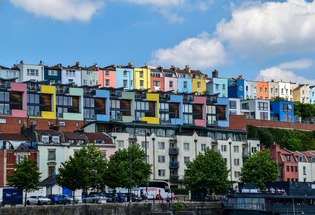Why Now Is the Time to Invest in Bristol Property

Located in the southwest of England, Bristol is positioned on the River Avon close to Bath, Weston-super-Mare, Swindon, and Stroud, with Cardiff and Newport in Wales located on the other side of the water. The city enjoys a temperate climate, close proximity to numerous stunning beaches, and excellent transport links to the likes of London, Birmingham, Liverpool, Manchester, and the Midlands.
These are just some of the reasons why Bristol is the southwest’s most populous city and a fantastic place to buy a home. But there are lots more. Read on to find out.
Bristol Boasts a Buoyant Economy
Bristol has twice been named as the best city to live in, which has fuelled the local arts, technology and creative scenes. Some of the biggest employers in the area include Airbus, Rolls Royce, and Hargreaves Lansdown.
Between April 2021 and March 2022, there were 268,400 economically active people in Bristol, with a model-based unemployment rate of just 3.4%. This figure highlights the resilience of employers in Bristol, which have maintained excellent rates of employment despite pandemic-related difficulties that have affected all industries. In fact, in 2021, Bristol was highlighted as having the UK’s third strongest local economy and data shows that this buoyancy is set to continue with an annual GVA of 2.2%.
Bristol is a Popular University City
Notably, more than 35% of the economically inactive population in Bristol during this time were students. Not only does this figure support the high number of economically active potential tenants landlords can expect to choose from when purchasing a buy-to-let property in the city, it also emphasises the number of student investment property opportunities that are available in the city.
This continued popularity has seen property prices in the city increase steadily over the last decade and, currently, the Bristol property market is seeing some of the fastest growth in the UK.
Bristol Property Has An Excellent Rental Yield
The area has a buoyant economy and significant popularity with students, young professionals, and families. In the BS24 postcode, where the average property reaches £309,052, the average rental yield sits at 3.9% and in the BS1 postcode, where the average property price sits at £328,854, it is reasonable to expect to secure an average rental yield of 5.3%.
Bristol has an Array of Popular Areas
As with every property investment, location is key, and Bristol has a variety of excellent areas to choose from. Three of the most popular areas in Bristol are below:
Clifton
The BS8 postcode is one of the areas that immediately springs to mind when thinking about Bristol because it is the home of the iconic Clifton Suspension Bridge. The area is incredibly popular amongst young professionals as there are an array of independent eateries, shops and cafes dotted around Clifton Village. During the last 12 months, the average property in Clifton sold for £558,905. This figure was 2% higher than the previous year and 15% higher than the average recorded in 2019.
Southville
This part of the city underwent a significant period of regeneration in the 1990s and now boasts a community feel and variety of independent businesses. It also benefits from being a short walk away from the harbour, which is a real selling point. Prices in this part of the city are notably lower than in Clifton, with the average property selling for £448,733. This average increased by 10% on the previous 12 months and by an absolutely massive 27% on the 2019 average.
Bishopston
This family-friendly part of the city is in the catchment areas for several of the most sought-after schools, including Redland Green. The average price for property in the area over the last year reached £511,598, which represented a 2% increase from the previous year and an 18% increase on the average price in 2019.
Bristol Will Continue to Grow
Between 2011 and 2021, Bristol’s population increased by 10.3% which was significantly higher than the overall 6.6% average increase seen across England and the 7.8% increase seen across the South West. This growth is showing no signs of slowing down, particularly as there are a host of investment projects planned.
The Temple Quarter is just one major development on the cards, which will create a brand new urban quarter situated close to Bristol Temple Meads railway station. In addition to redevelopments to the station itself, the project will also see the creation of 11,000 properties plus retail and leisure units that will provide 17,000 new jobs over the next two decades.
Investors should keep a close eye on plans for the old Filton Airfield area, which could see the creation of a new garden suburb including a concert venue and more than 2,600 homes. Plus, investors keen to target the student rental market should be interested in plans from the University of Bristol to create a new Temple Quarter campus, which could see student numbers grow by 30%.
